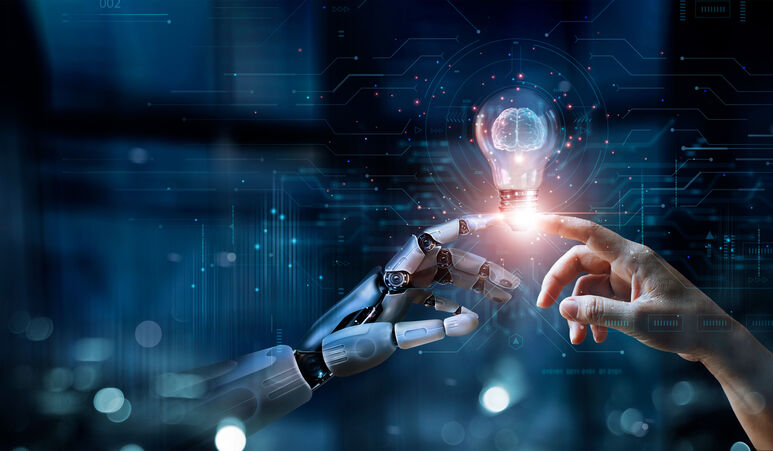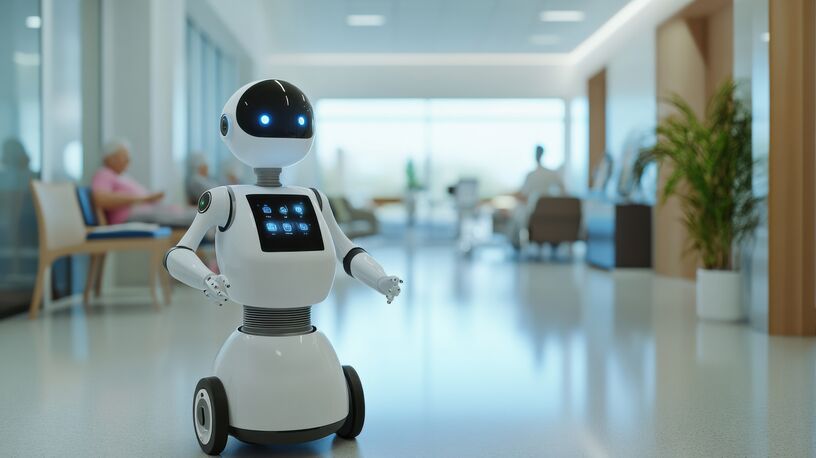The use of artificial intelligence (AI) in companies offers great potential for securing skilled labour and is playing an increasingly important role in times of skills shortages. AI can help to reduce the shortage of skilled labour by taking over tasks that previously had to be performed manually or by highly qualified personnel. By automating routine tasks and providing support for more complex activities, AI can relieve the burden on the workforce and enable skilled labour to be deployed more efficiently.
Contributions of AI to securing skilled labour
In the case of AI, the term "increased efficiency" covers a variety of application dimensions that create added value. The following fields provide a compact overview:
- Automation and AI-based assistance: AI-based automation of activities can reduce the future need for skilled labour in some areas. AI can increase productivity and support and relieve the burden on employees. Conversely, professions with particular challenges for recruiting skilled labour can be upgraded through AI, as AI automation contributes to a more attractive design of the work. It can also help to facilitate working time and work location models, thereby activating hidden reserves in the labour market.
- Integration into the labour market: The pool of potential employees must be used even better to meet the specific demand for skilled workers and enabled to participate in the labour market with suitable framework conditions. The key question will be how the pool of suitable skilled labour can be increased through AI. Important elements here are the integration of the (long-term) unemployed, the inclusion of people with disabilities and older people in the labour market and the facilitation of targeted skilled labour migration.
- Knowledge transfer into the future: AI can support the upskilling of employees. This refers to the expansion of skills and competences. Important elements include individualised training plans, AI-based knowledge transfer and working environments that are conducive to learning and experience (with and through AI). The use of AI should not lead to simplification and de-skilling (i.e. a reduction in the level of qualifications), but rather - in the sense of rich and good work - enable people to gain experience and learn in the work process.
Concrete application examples
In principle, the use of AI in the context of securing skilled labour is not limited to one sector of the economy. In industry, the use of AI-controlled robots can make monotonous or physically demanding tasks easier, allowing skilled workers to concentrate on more challenging tasks such as maintaining and optimising systems. AI can also help reduce the workload in the healthcare sector by being used in image diagnostics to analyse X-rays or MRI images. This frees up valuable time for medical professionals to focus on patient care. The following examples describe examples that can also be found in the Baden-Württemberg corporate landscape.
- AI-supported robots as support workers in the service department
Self-learning systems equipped with appropriate sensor technology help with loading and unloading (e.g. laundry industry) or transporting goods (e.g. supermarkets, restaurants). They do not replace people, but expand the range of tasks. In addition to voice and gesture control, teleoperation, face and text recognition can be realised. AI thus opens up a wide range of applications in which it can work directly with humans or perform dangerous tasks with minimal supervision. This is achieved through AI-supported environment and object recognition, object tracking, environment mapping and simulated programming. - AI applications for the technical documentation of data
Artificial intelligence is used to automatically, quickly and securely map and process digital data chains, content delivery or standardised exchange formats in areas such as mechanical and plant engineering and medicine. The software has been developed for technical documentation. Regardless of whether it involves the allocation of metadata, the extraction of knowledge or the implementation of standards. A lot of time can be saved by using the software. - Social robots in care
Social robots, which are designed for communication and interaction, support nursing staff in hospitals and senior centres. Using AI and appropriate sensor technology, they can move around rooms independently and hold conversations. By accessing ChatGPT, for example, they impart knowledge and recognise the facial expressions and gestures of their counterparts so that they can also respond to non-verbal signals. AI allows them to respond to patients and those in need of care in an empathetic and empowering way. The social robots do not replace the work of human carers, but enable additional interactions so that carers have time for other tasks, especially when workloads are high. In addition, the use of social robots also stimulates technological knowledge among employees and promotes dialogue on the ethical aspects of technological change.
Listen to a podcast from Wirtschaft digital on the topic of "social robots in geriatric care"here!
Critical questions and ethical aspects
Despite all the efficiency gains and positive economic aspects, it is essential to bear in mind that new technologies bring with them a situation of upheaval, which is sometimes accompanied by losses and creates uncertainty. This applies in particular to the following topics, which can only be summarised here:
Fear of job loss and deepening inequality between professional groups
Lack of transparency and responsibility in the face of self-learning systems that make automated decisions
Wrong decisions and discrimination, especially in personnel decisions, if AI is used in recruiting and other personnel management issues
Loss of humanity in the world of work and the risk of humanising machines and thus distorting reality
Data protection and loss of privacy when using AI to handle employee data
Increasing dependence on AI in companies and loss of autonomy
As the increasingly rapid spread of AI is a new experience for companies, particularly in relation to HR issues, the associated challenges are also new. Avoidance or concealment are certainly not the right strategy for dealing with these issues in order to retain employees or attract new ones. Much more important here are aspects such as further training and information events to give employees sufficient space to express their concerns and at the same time recognise the opportunities of AI for their own professional context.


